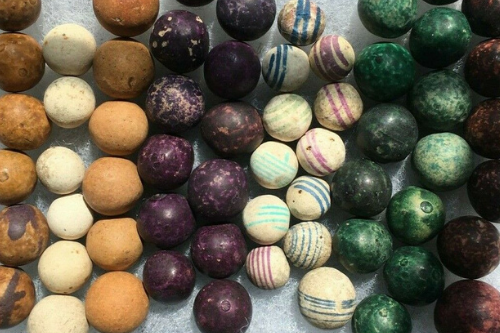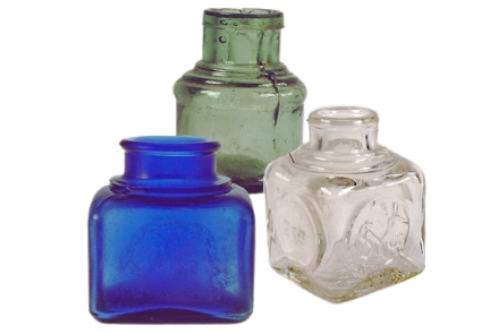
Historic Ink Bottles
Historical archaeology connects places, things, and issues from the past or present using not only what is found during an excavation, but also written records and oral traditions that then help inform and contextualize cultural materials.
During the spring of 2021, Palomar College students in Professor Betsy Pain’s Anthropology 225 class created videos that can be used as comparative or reference collection guide, which are useful for educational and research purposes. This video series highlights different types of historic artifacts for which students compiled research. If you have any questions about these artifacts or topics, please email collections@sandiegoarchaeology.org.
Historic Ink Bottles
By Sue Hagen
Summary compiled by Collections Manager Jessica McPheters
Sue Hagen is a student in the Palomar College archaeology program and a former intern at the SDAC.
History of Ink
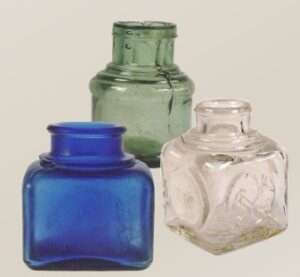
Ink bottles are utilitarian artifacts that can be simple or ornate, and many different types of people from all walks of life and socioeconomic backgrounds have used them. This presentation focuses on small glass ink bottles intended for personal use in the home or by an individual in an office setting.
Humans have used pigments for painting for more than 40,000 years. During the 23rd century BCE (Before Common Era), Chinese cultures used various types of ink for painting and writing. What is commonly known as India Ink was made in China from ingredients sourced out of India. India Ink was waterproof, which made it ideal for artists. Iron Gall Ink, made from tannin, was used for more than 1,400 years in Europe, parts of Asia, and eventually the United States until approximately the 19th century.
In the 19th-century United States alone, there were more than 300 ink makers, selling a wide range of different types of inks. These inks came in various bottles in many different colors.
Once the Civil War ended, colonists expanded their territory to the West so people moved further apart from their family and friends. Written letters were a popular form of communication even after the introduction of the telephone, and ink was considered a necessary commodity. It was not until the 1960-70s that these companies began to decline with the invention of the ballpoint pen.
Ink Bottle Manufacturing
For more detailed explanations on the bottles discussed in this section, visit the Society for Historical Archaeology.
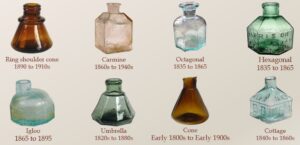
The earliest examples of ink bottles made from glass were free blown. This type of bottle is identified by scarring and unevenness in the glass. Mold-blown bottles were next to be manufactured. The scarring was no longer present, and the two early methods of this type of bottle manufacturing had specific finishes on the tops of the bottles. Rolled or folded finishes gave the bottles a smoother look, and applied finishes were created using additional glass to form flare or ring designs. Tool finishes were unique and gave bottles a cleaner look. Bottles made with the automatic bottle machine were introduced in the early 1900s. These could be produced more rapidly and have a consistent appearance. Typically, the bottles used by ink makers were shipped in from outside bottle makers. Many do not include maker’s marks, but by researching old advertising, some makers can be matched to their product.
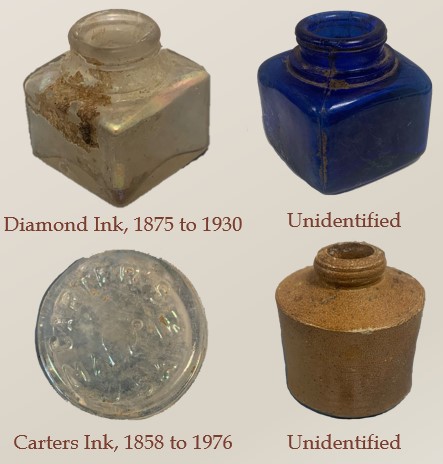
Before the 1950s, ink bottles were produced in a wide variety of colors. The colors also help date the bottles. Colorless bottles were hard to produce since they required very pure ingredients. Therefore, they were uncommon in ink bottle manufacturing until the 1870s. After the creation of the automatic bottle machine in 1910, colorless glass became the most common. Aqua was uncommon after 1920 and cobalt after the 1930s.
The shape of ink bottles also varied widely. Ink bottles can be square, conical, rectangular, octagonal, and more. Shapes such as cottages, barrels, domes, and igloos were also popular. Different shapes are also helpful in dating ink bottles. Thousands of patents were issued for the different shaped ink bottles.
Ink Bottles in the SDAC Collections
Enjoy this informative video to learn all about ink bottles and their history. Come back next month to learn about marbles!


